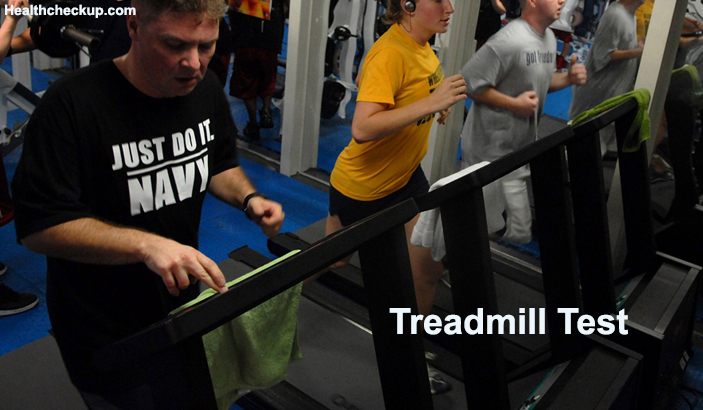The treadmill test, also known as the cardiac stress test, is mainly used by cardiologists to determine the effects of exercise on a person’s heart. The test helps doctors to detect irregular heartbeat or arrhythmias and also diagnose the presence of Coronary Artery Disease (CAD).
Coronary Artery Disease is the most common type of heart disease that occurs when the arteries supplying blood to the heart become narrowed and hardened due to the buildup of cholesterol, called plaque on the inner walls of the arteries. The narrowing of the arteries restricts the blood flow to the heart muscle, thus limiting the oxygen supply to the heart. This causes the patient to experience chest pain, called Angina, or shortness of breath, and sometimes, a heart attack.
The treadmill test will help your cardiologist how much stress your heart can take before you develop irregular heartbeat or the blood flow to the heart decreases during exercise.
Principle Behind The Treadmill Test
The principle behind the exercise stress test is simple. In a healthy person, the coronary arteries dilate during exercise and increase blood supply to the heart. But, if the coronary arteries are narrowed or blocked, there is no dilation during exercise, and the restricted blood supply to the heart muscle will cause it to starve, producing symptoms such as pain or discomfort in the chest and shortness of breath.
There may also be changes in the ECG readings which may not be apparent when the patient is at rest. Thus, the treadmill test or the cardiac stress test helps cardiologists confirm the suspicion of coronary artery disease in a patient and determine the effects of exercise on a patient already diagnosed with coronary artery disease and the effectiveness of the treatment that the patient is undergoing.
Why is the Cardiac Stress Test Done?
The purpose of the cardiac stress test is to
- Help diagnose the underlying causes for symptoms such as palpitations, chest pain and shortness of breath, and determine if these symptoms are arising due to heart disease.
- Determine the normal functioning of the heart valves
- Identify irregular heart rhythms, which might not be evident when the patient is at rest
- Confirm the diagnosis of coronary artery disease and determine if more specific diagnostic tests are needed
- Determine the effectiveness of heart medication for persons already diagnosed with heart disease
- Determine the exercise tolerance in patients with heart disease and help design a safe exercise program for them
Stress Test Guidelines: How to Prepare for a Cardiac Stress Test?
You may have to observe the following guidelines before you go for a cardiac stress test:
- Avoid eating or drinking anything except water for 4 hours prior to the test.
- Avoid any caffeinated drinks for at least 12 hours before the test.
- If you use an inhaler regularly, do not forget to take it along with you while going for the test.
- Make it a point to wear comfortable clothing, including comfortable footwear to the test.
- Do not forget to ask your doctor if you should take or avoid any regular medication you are on, on the day of the test. Usually, your doctor will advise you to avoid heart medications that have the following components isosorbide dinitrate, isosorbide mononitrate and nitroglycerine, on the day of the test. But, sometimes, the doctor may advise you to take your regular medication, so it is very important to check with your doctor which medicines are suitable to take, and which medicines should be avoided on the day of the test.
[Read – Fasting Before Blood Test Purpose]
The Procedure for the Cardiac Stress Test
The test is usually performed in an exercise laboratory by a well-experienced technician or the cardiologist himself, and the procedure for the test is as follows:
1. The technician or the doctor performing the test will first explain the test to you and answer any questions that you ask regarding the test. He will also record a brief medical history.
2. In most hospitals and laboratories, you will be required to sign a consent form before undergoing the test.
3. You may be asked to remove any clothing on your upper body, and wear a gown with an opening in the front.
4. Adhesive electrodes are stuck onto the chest to capture the ECG, and the areas where the electrodes are placed are usually cleaned with spirit and shaved if needed, before placing the electrodes.
5. Next, your resting blood pressure, heart rate and ECG are recorded before you get onto the treadmill. If your blood pressure is unusually high before the test, the test will be postponed.
6. Then, you will be asked to step onto the treadmill and start walking. You will start by walking slowly at the beginning, and the speed and inclination will be increased at set intervals. Since the test is effort-dependent, it is very important that you walk as long as possible.
7. The cardiologist or technician will continuously monitor you during the test and will stop the test immediately if any problem occurs. You should notify the person conducting the test instantly if you experience any untoward symptoms like chest pain, dizziness or light-headedness, shortness of breath or extreme fatigue.
8. Once the test is done, the doctor/technician will ask you to lie down and monitor your blood pressure, heart rate and ECG for about 5 minutes after exercise.
9. The data is reviewed by the cardiologist after the test is concluded, and the report will be sent to any other doctors involved in your healthcare.
The entire test may take about 30 to 45 minutes to perform, depending entirely on the exercise capacity of the patient and also the information acquired during the test. Also, the test is not performed for patients suffering from conditions such as narrowed heart valves, or patients who have recently experienced a heart attack and those suffering from severe heart failure.
Once your doctor(s) reviews the test results, he may order a further diagnostic investigation to obtain a clear picture of your heart health.
Cardiac Stress Test Results
The cardiac stress test helps cardiologists and other healthcare specialists evaluate the exercise tolerance in patients with suspected Coronary Artery Disease (CAD) who have unexplained symptoms such as fatigue and shortness of breath. The test also helps evaluate the blood pressure response to exercise in patients with borderline hypertension and look for an exercise-induced irregular heartbeat which could be serious.
In patients with known coronary artery disease, the test will help diagnose if the patient is in a stable state or if he or she is developing a new blockage. The test results will also help the doctor to determine whether to continue the present line of treatment or make modifications depending on the patient’s health status and order further investigations if necessary.
Risks Involved in the Test
The exercise stress test is conducted under the close supervision of a physician or an experienced lab technician, and the risks are very rare, but, in patients with severe coronary artery disease that hasn’t been diagnosed yet, the test may trigger chest pain and cause a sudden heart attack. Therefore, it is very important for the person conducting the test and the person undergoing it to be fully aware of any signs and symptoms that suggest a health crisis.
A treadmill test is therefore, useful in diagnosing the cause for unexplained chest pain and helpful in determining the extent of blood flow to the heart. However, the results of this test are not all conclusive and may prompt for further investigations such as cardiac catheterization, Echo stress test or a nuclear stress test.
Medically Reviewed By

I am an experienced Medical/Scientific writer with a passion for helping people live a happy healthy life. My thirst for writing has followed me throughout the years – it is there when I wake up, lingering at the edges of my consciousness during the day, and teases me at night as I go to sleep.









